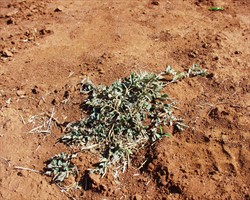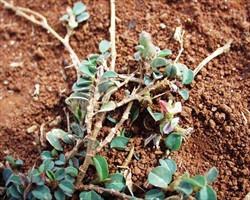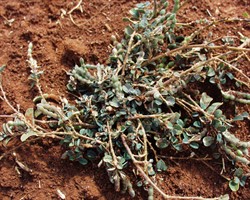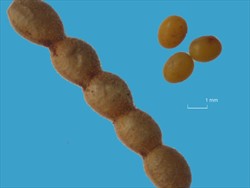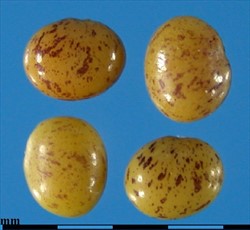Alysicarpus monilifer
Tropical Forages
Alysicarpus monilifer (L.) DC.
Basionym: Hedysarum moniliferum L.
Family: Fabaceae (alt. Leguminosae) subfamily: Faboideae tribe: Desmodieae subtribe: Desmodiinae.
Low growing, much branched, deep rooted annual or perennial herb, 5–15 (‒50) cm tall. Branches pilose, hairs long and spreading. Leaf unifoliolate; broadly oblong or elliptic-oblong, rounded and mucronulate at the apex, subcordate at the base, 0.4‒2.5 × 0.4‒1.5 cm, prominently nerved, glabrous above, sparsely pubescent on the nerves beneath; petiole 3‒6 mm long; stipules 3‒8 mm long, lanceolate, scarious, striate. Racemes spicate, axillary and terminal, 1–15 cm long; flowers 4‒10, lax to dense along racemes, pedicel to 2 mm long, calyx lobes lanceolate, ciliate; corolla pink to violet; standard to 5 × 2 mm; wings to 4 × 2 mm; keels to 6 mm long. Pods moniliform, 2- to 8-jointed, 1.2–2.5 cm long, turgid; glabrous or sparsely pubescent; articles 2.5–3 mm long and 2–3 mm wide, loment finely downy with minute hooked hairs, surface obscurely to distinctly veined. Seeds sub-globose or oblong, brown to yellow mottled; 350,000 seeds/kg.
English: necklace-pod alyce clover
India: samervo (Gujarati), chatta-ki-ghas, juhi ghas, jhuhighas (Hindi), kallu naamada soppu, thalemaddina gida (Kannada), kacukkoti (Tamil), amera (Telugu)
Native:
Africa: Ethiopia; Niger; Sudan
Asia: India (Madras, Jammu, Punjab, Gujarat, Madhya Pradesh and Uttar Pradesh); Pakistan; Myanmar
Indian Ocean: Mauritius; Réunion
Forage
Common in mixed species native pasture. Could make useful contribution in moderately to heavily grazed, long-term and ley pastures in low to medium rainfall areas.
Other
Used in India as an anti-flammatory, as a diuretic and as a cure for stomach ache; also considered a treatment for snakebite. The root is reported to be a substitute for liquorice.
Soil requirements
Grows on a wide range of soil types from deep sands and stony soils to cracking clays with a pH range of 5.5–8. Appears during the rains in grassy places, rocky hillocks and wastelands.
Moisture
Perennial types from India are found in areas with 600–1,500 mm annual rainfall, and annual types from Sudan in areas with 200–400 mm, and a short (<3 months) growing season.
Temperature
Mainly tropical lowlands (0–1,000 m asl) with average daily temperature range of 26–29 ºC. Perennial types are readily frosted but annuals because of early maturity largely avoid frost.
Light
Not tolerant of lenient grazing in legume-grass associations, suggesting a preference for full light.
Reproductive development
At 21 ºS, flowering can occur at 60–70 days after establishment and seed can be mature at 90 days (annuals) and 110–115 days (perennials). Seed retention is poor with moniliform pods readily disarticulating between articles. A high percentage (>70%) of seed is hard at maturity. Flowers August‒October (‒November) at 21º N in India.
Defoliation
Prostrate types more tolerant of intensive grazing in permanent pastures while the more erect forms are better adapted to less intensive grazing.
Fire
Response to fire in the vegetative state is not known but heavy and early seeding should minimise the chances of loss from pastures that are inadvertently burnt.
Guidelines for establishment and management of sown forages.
Establishment
Moderate seed size and a relatively fast germination rate give quick and reliable establishment. Some form of seed scarification to break hard seed may be necessary. Not highly competitive with weeds or established perennial pasture plants.
Fertilizer
Could be expected to respond to P, K and S on soils that are deficient or respond to lime or dolomite if below the optimum pH range of 6–8.
Compatibility (with other species)
Appears best suited in combination with less vigorous grasses. Heavy grazing or extreme dry seasons that set back companion grasses may enhance legume persistence and spread. Seedling regeneration has been successful at low to medium rainfall sites in a sub-humid environment on the tropic where competition from grass was not extreme.
Companion species
Grasses: In India, A. monilifer is often found with Bothriochloa, Dichanthium, Chrysopogon and Heteropogon on rocky or eroded areas where grazing is heavy.
Pests and diseases
Leaves, petioles, axillary buds, stems and fruits parasitised by the wart fungus, Synchytrium cookii in India.
Ability to spread
Early seeding and probable ability to withstand heavy grazing could result in spread from sown areas.
Weed potential
Low growth habit limits its ability to dominate companion species.
Nutritive value
No information available.
Palatability/acceptability
Well eaten by cattle.
Toxicity
No record of toxicity.
Dry matter
Low to moderate yields in experimental sowings in Queensland, Australia.
Animal production
No information available.
While some provenance comparisons have been conducted in India, no breeding programs have been undertaken. 2n = 16.
Flowering & fruiting: August–October in India. Free seeding and relatively large seed, but difficult to harvest because of low growing habit and disarticulation of pod articles.
No information available.
- Easily established.
- High palatability.
- Tolerant of moderately heavy grazing.
- Low DM yield in mixed pastures.
- Frost tender.
Gramshaw, D., Pengelly, B.C., Muller, F.W., Harding, W.A.T. and Williams, R.J. (1987) Classification of a collection of the legume Alysicarpus using morphological and preliminary agronomic attributes. Australian Journal of Agricultural Research 38:355–372. doi.org/10.1071/AR9870355
None released.
